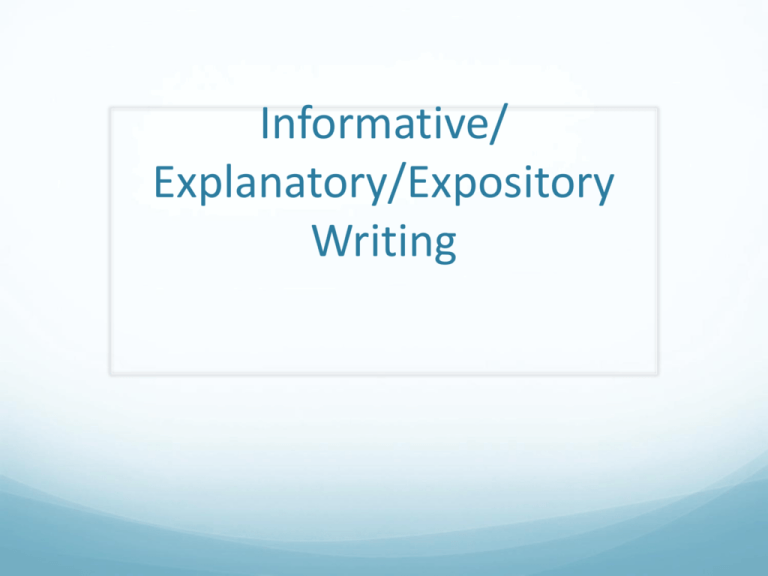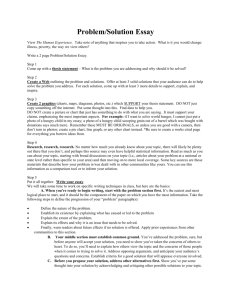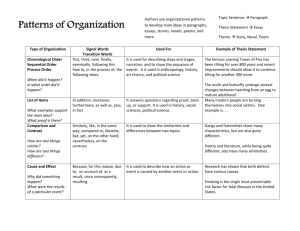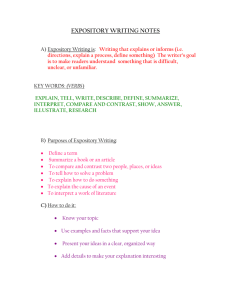Introduction to Expository Writing
advertisement

Informative/ Explanatory/Expository Writing Expository Writing Expository is another word for explaining. In an expository essay you may be asked to give information about something or you might be asked to explain something. Example: What is your favorite sport and why? Clue words: explain, discuss, show, clarify, inform, describe, talk about, tell/write why, explain how, compare/contrast, show the causes/effects of Essay Structure There is no ONE WAY to structure an informative essay. The strategy you use to structure an essay depends upon your purpose and your topic. Sometimes you can incorporate more than one strategy in a single essay. Strategies Definition Cause and Effect Analysis Comparison and Contrast Process Analysis Example Division or Analysis Classification Definition Possible Topics A current slang expression Bullying in the digital age A good friend Cowardice Self-respect Stop and frisk Osmosis The Great Depression Occupy Wall Street Introduction Suggestions Provide a base from which to expand while explaining why the forthcoming definition is useful, significant, or necessary You may report the incident that prompted you to define why the subject is important. Specify the common understandings, or misunderstandings, about its meaning. Introduction (continued) Discuss the etymology of the word. Offer a quote from another writer supporting or contradiction your definition. Offer an explanation of what it does NOT mean. State your thesis so readers will know precisely what you purpose and point are. AVOID the overused “The American Heritage Dictionary defines _________ as . . . Body Organization Suggestions Connect to your perspective (thesis point). Proceed paragraph by paragraph to refine the characteristics or qualities of the subject, arranged to distinguish it from other similar subjects. Draw increasingly tight boundaries from broader and familiar to the one you have in mind. Organization Continued . . . Arrange points in order of increasing drama. Begin with your own experience with the subject and show how you see it operating in your surroundings. Conclusion Suggestions Summarize your definition. Indicate its superiority to other definitions of the same subject. Quote another writer whose view supports your own. Recommend how readers can make use of the information you have provided. As always, the choice of conclusion in any essay depends on your purpose and the impression you want to impart. Compare and Contrast Analysis Possible Topics A memory of someone and a recent encounter Two pieces of literature with similar themes but different styles Older and newer version of a product Heroes today and in ancient Greece The views of two political candidates Two different chemical reactions Two cars Compare and Contrast They usually work together. This strategy is good for subjects that warrant side-by-side comparison. The subjects usually resemble each other in some respects but differ in others. Explanatory Comparison Explain the similarities and differences between subjects so as to make either or both of them clear. An explanatory comparison does NOT take a position on the relative merits of the subjects. Example: Explain how the new teen driving laws differ from the old laws. Evaluative Comparison Evaluate subjects so as to establish their advantages/disadvantages, strengths/weaknesses, etc. The evaluative comparison DOES take a position and usually concludes with a preference or a selected course of action. Example: Argue how the new teen driving laws prevent more accidents than the old laws did Explanatory/Evaluative Both types of comparisons treat two or more subjects from the same general class. Identify features shared by both—points of comparison. This assures a direct rather than a random comparison. Example: diets—forbidden foods, allowed foods, speed of weight loss, nutritional quality Introduction Suggestions Decide whether you are going to explain the similarities and differences between subjects in order to make either or both of them clear—an EXPLANATORY comparison OR you are going to evaluate the subjects in order to establish their advantages and disadvantages—an EVALUATIVE comparison. Your THESIS will depend on this decision EXPLANATION: Though rugby requires less strength and more stamina than American football, the two games are very much alike in their rules and strategies. EVALUATION: The two diets result in similarly raid weight loss, but Harris’s requires ;much more self-discipline and is nutritionally much h riskier than Marconi’s. Body Organization Suggestions Generally give subjects equal emphasis when they are equally familiar or are being evaluated. Stress one subject over the other when it is less familiar. Generally stress similarities and differences equally when all the points of comparison are equally familiar. Organization Continued . . . Stress the differences with subjects that are usually considered similar. Stress the similarities between subjects that are usually considered different. Subject-by-subject: each one is explained in full, one before the other (usually reserved for short essays) Point-by-point: points are covered one at a time (usually the more useful approach) Conclusion Suggestions Help the reader see the whole picture. Comment on the significance of the comparison. Advise readers on how they can use the information. Recommend a specific course of action for readers to follow. Cause and Effect Analysis Possible Topics A change of mind about an important issue What accounts for the popularity of ___________ ? Why is the United States facing an economic crisis? How does a person’s addiction impact his/her family? What effects do you expect your work ethic to have on your career choice? Speculate on the resulting reaction when you combine _____ and ______ and explain why that will occur. Why do people root for the underdog? Purpose Use this method when dividing occurrences into their elements to find relationships among them. Analyze CAUSES to discover which of the events PRECEDING a specified outcome actually made it happen. Analyze EFFECTS to discover which of the events FOLLOWING a specified occurrence actually resulted from it. Purpose Continued . . . Your purpose in analyzing might be to EXPLAIN or to PERSUADE. • EXPLAIN: order experience and pin down the connections in it. ARGUE: show why one explanation of causes is more accurate than another OR how a proposed action will produce desirable or undesirable consequences. The Challenge Related events sometimes overlap, sometimes follow each other immediately, and sometimes connect over gaps in time. Events vary in duration and complexity. Events vary in importance. Analysis requires identifying them, but also discerning their relationships accurately and weighing their significance fairly. Challenges Continued . . . Causes and effects often occur in a sequence, each contributing to the next in a CAUSAL CHAIN. Identifying this chain involves sorting out events in time: IMMEDIATE: the causes or effects occur nearest the event REMOTE: the causes or events occur further away in time. Challenges Continued . . . Analyzing causes also requires distinguishing their relative importance in the sequence: MAJOR: These causes are directly and primarily responsible for the outcome. MINOR: These causes (also called CONTRIBUTORY) merely contribute to the outcome. Pitfalls A confusion of the coincidence and the cause—in other words, an assumption that because one event preceded another, it must have caused the other (post hoc—”after this, therefore because of this) Examples: superstitions illustrate post hoc A accuses B of ________ . B is upset and leaves in his car. Shortly after, B has an accident. B’s friend accuses A of causing the accident. In the absence of proof, the friend commits the error of post hoc by asserting that A caused B’s accident simply because his accusation preceded the accident. Pitfalls Continued . . . OVER-SIMPLIFICATION: consider not only the causes and effects that seem obvious but all possibilities: remote as well as immediate, minor as well as major. NECESSARY cause: one that must happen I order for an effect to come about; an effect can have more than one necessary cause. SUFFICIENT cause: one that brings about the effect by itself. Pitfalls Continued . . . Over-simplification can also occur if you allow opinions or emotions to cloud the interpretation of evidence. To achieve a balanced analysis, you have to put aside your own feelings and consider all possible causes for the occurrence. Planning/Prewriting Whether your subject suggests a focus on causes, effects, or both list as many of them as you can from memory or from research. Ask: Why did it happen? What contributed to it? What were or are the result What might its consequences be? One or more of these questions should lead you to a focus for the essay. Planning Continued . . . Arrange the causes or effects in sequence and weigh their relative importance. Anticipate the expectations and needs of your audience, considering what they already know and what they need to be told. Develop a THESIS that states your subject, your perspective on it, and your purpose. The thesis should reflect your judgments about the relative significance of possible causes or effects. Introduction Suggestions Pull readers in by describing the situation whose causes or effects you plan to analyze. Provide background—a brief narrative of the situation, a summary of the analysis of causes and effects that your essay will dispute. If your thesis is not already apparent, stating it explicitly can tell readers exactly what your purpose is and which causes and effects you plan to highlight. (If you anticipate readers will oppose your thesis, you may wait to state it until the end after you have provided proof.) Body Organization The arrangement of your ideas will depend on your material and your emphasis. CHRONOLOGICAL ORDER for events that unfold in a causal chain—each event causing another effect. ORDER OF IMPORTNCE if events overlap or vary in significance, try. Tis shows which events are major and which minor and reserves your most significant (and most detailed) point for last. Conclusion Suggestions You may want to restate your thesis—or state it if you deliberately withheld it for the end—so that readers are left with the point of your analysis. If your analysis is complex, readers may benefit from a summary of the relationships you have identified. Depending on your purpose, you may want to specify why your analysis is significant, what use the readers can make of it, or what action you hope they will take. Works Cited* Aaron, Jane E. 40 Model Essays: A Portable Anthology. Boston: Bedford, 2005.





